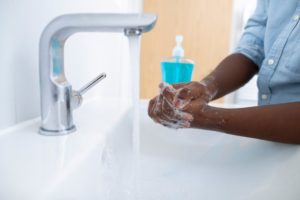
A COVID-19 infection count is being constantly flashed across TV screens across the nation, making the pandemic even more daunting than it already is. During this time, it’s a good idea to focus on everything that you can control and establishing safe and effective hygiene practices that can reduce your risk of contracting the virus. Because it’s spread by droplet transfer to your mucous membrane (eyes, nose, mouth), it’s especially important to sanitize and disinfect each time before you put anything in your mouth, like when you brush and floss. Read on to learn five dental practices from your dentist that can help reduce your risk of COVID-19.
Thoroughly Wash Your Hands Before Brushing
The CDC has confirmed that frequent and regular hand hygiene is one of the most important preventive steps you can take during the COVID-19 pandemic. Since scientists and researchers know that the virus is spread from your hands coming into contact with your nose, mouth, or eyes, and exposing the virus to your mucous membrane, it’s important to remember to wash your hands for at least 20 seconds before you carry out your dental hygiene routine.
Disinfect Your Toothbrush Regularly
Bacteria and viruses can easily become trapped on your toothbrush bristles and handle, which is why it’s important to regularly disinfect them. You can do this three different ways:
- Soak the handle in a mixture of one part bleach to nine parts water or in a 70 percent alcohol solution.
- Boil your toothbrush for 5 minutes.
- Run your toothbrush through a full dishwashing cycle.
Clean Your Toothbrush Holder
One of the dirtiest and most bacteria-filled areas of your house is at the bottom of your toothbrush holder. Often times, water gets trapped in this dark area, creating the perfect breeding ground for bacteria. That’s why it’s important to regularly disinfect it, to keep you from becoming sick due to the transfer of this bacteria to your mouth. You can do this by soaking it in a bleach and water solution and rinsing it out, or running it through your dishwasher.
Do Not Share Dental Products
Even with your family, it’s important to reduce the amount of contact that you have with others. That’s why it’s a good idea to avoid sharing any dental products, such as a toothbrush or waterpik. If you absolutely must have to, be sure to sanitize them after each use.
Immediately Replace Your Toothbrush After Getting Sick
Even outside of the COVID-19 pandemic, you should always replace your toothbrush after you get sick to prevent any chance of reinfection. Bacteria can easily become trapped in the bristles of your brush and stay there for days. Plus, since scientists aren’t sure how long the virus is able to survive on surfaces at this time, it’s a good idea to have a few extra toothbrushes on hand.
The best way to protect yourself is to put effective preventive measures into place and remember to keep up with great hygiene practices, even when you’re in the comfort of your own home. With these five tips listed above, you’ll be able to increase your chances of staying healthy through this pandemic.
About the Author
Dr. Vacek has been practicing dentistry in Waverly for about a decade. He focuses on getting to know his patients and providing them with the highest quality of preventive treatment. He regularly takes continuing education courses to stay up-to-date with the latest that the dental world has to offer and is an active member of several professional organizations as well. For questions or to schedule a consultation, visit Amberly Dental’s website or call 402-786-2007.
